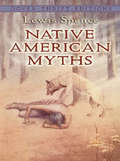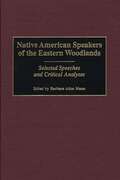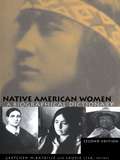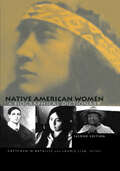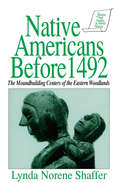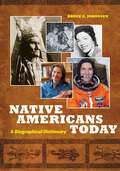- Table View
- List View
Native American Issues: A Reference Handbook (Contemporary World Issues)
by William N. ThompsonThis handbook provides an unbiased, in-depth assessment of the struggles, successes, and status of Native Americans in what is now the United States from the time of the first European settlers to the present.Native American Issues: A Reference Handbook, Second Edition explores the history, problems, and contemporary issues faced by peoples of Native American heritage. From the Indian Removal Act of 1830 to the "Twenty Points" platform advanced by the American Indian Movement in the 1970s to the massive budget cuts of the 1980s, readers will discover how the well-being of Native Americans has been affected by federal and state policies.Refocusing the first edition's underlying theme of sovereignty to highlight issues related to community, this extensively updated volume addresses the greatest single change in the condition of Native Americans in the last decade—the proliferation of gambling enterprises. Issues such as land claims, use of natural resources, sacred sites, governments, and stereotyping are examined from the perspective of strengthening community.
Native American Literature: A Very Short Introduction (Very Short Introductions)
by Sean TeutonNorth American indigenous literature began over thirty thousand years ago when indigenous people began telling stories of emergence and creation, journey and quest, and heroism and trickery. By setting indigenous literature in historical moments, Sean Teuton skillfully traces its evolution from the ancient role of bringing rain and healing the body, to its later purpose in resisting European invasion and colonization, into its current place as a world literature that confronts dominance while celebrating the imagination and resilience of indigenous lives. By the time Europeans arrived in North America indigenous people already understood the power of written language and the need to transmit philosophy, history, and literature across generations and peoples. Seeking out multiple literary forms such as sermon, poetry, and novel to serve differing worldviews, indigenous authors have shaped their writing into North American indigenous literature as we recognize it today. In this lucid narrative, Sean Teuton leads readers into indigenous worlds. He describes the invention of a written indigenous language, the first indigenous language newspaper, and the literary occupation of Alcatraz Island. Along the way readers encounter the diversity of indigenous peoples who, owing to their differing lands, livelihoods, and customs, molded literature to a nation's specific needs. As Teuton shows, indigenous literature is one of the best places for understanding indigenous views about land and society and the role of humanity in the cosmos. In turning to celebrated contemporary authors such as Thomas King, Leslie Silko, Sherman Alexie, Louise Erdrich, and James Welch, Teuton demonstrates that, like indigenous people, indigenous literature continues to survive because it adapts, both honoring the past and reaching for the future.
Native American Literature: A Very Short Introduction (Very Short Introductions)
by Sean TeutonNorth American indigenous literature began over thirty thousand years ago when indigenous people began telling stories of emergence and creation, journey and quest, and heroism and trickery. By setting indigenous literature in historical moments, Sean Teuton skillfully traces its evolution from the ancient role of bringing rain and healing the body, to its later purpose in resisting European invasion and colonization, into its current place as a world literature that confronts dominance while celebrating the imagination and resilience of indigenous lives. By the time Europeans arrived in North America indigenous people already understood the power of written language and the need to transmit philosophy, history, and literature across generations and peoples. Seeking out multiple literary forms such as sermon, poetry, and novel to serve differing worldviews, indigenous authors have shaped their writing into North American indigenous literature as we recognize it today. In this lucid narrative, Sean Teuton leads readers into indigenous worlds. He describes the invention of a written indigenous language, the first indigenous language newspaper, and the literary occupation of Alcatraz Island. Along the way readers encounter the diversity of indigenous peoples who, owing to their differing lands, livelihoods, and customs, molded literature to a nation's specific needs. As Teuton shows, indigenous literature is one of the best places for understanding indigenous views about land and society and the role of humanity in the cosmos. In turning to celebrated contemporary authors such as Thomas King, Leslie Silko, Sherman Alexie, Louise Erdrich, and James Welch, Teuton demonstrates that, like indigenous people, indigenous literature continues to survive because it adapts, both honoring the past and reaching for the future.
Native American Mythology (Native American Ser.)
by Hartley Burr AlexanderThis fascinating and informative compendium of Native American lore was assembled by one of twentieth-century America's premier ethnographer/anthropologists. Hartley Burr Alexander recounts the continent's myths chronologically and region-by-region, offering a remarkably wide range of nomadic sagas, animist myths, cosmogonies and creation myths, end-time prophecies, and other traditional tales.The stories begin in the far North, among Norsemen and Eskimos, and range through the land of the forest dwellers, with extensive representation of tribes such as the Iroquois and Algonquian. Legends from the Gulf region and Great Plains encompass sun worship and trickster pranks, and from the Indians of the mountain and desert come tales of Navajo gods and episodes from the ghost world. The collection concludes among the natives of the Pacific coast, with stories of secret societies, totemism and totemic spirits, and the Raven Cycle — the supernatural lore surrounding the black bird who hung the sun, moon, and stars in the sky, put the salmon in the rivers and the fish in the sea, and amused itself by fooling people with its shape-shifting tricks.
Native American Myths
by Lewis SpenceDrawn from the myths and legends of the Algonquins, Iroquois, Sioux, Pawnee, and Northern and Northwestern Indians, these enchanting tales offer insights into tribal character and beliefs. Selected by the distinguished British anthropologist and folklorist Lewis Spence, they range in theme from romantic love to rivalry between warriors to victory over powerful forces. The details of their recounting evoke images of Native Americans' innermost aspirations and fears as well as their larger worldview.A major forerunner of modern studies of myth, this compelling book blends the legends with factual material, giving each myth a meaningful perspective. Students of anthropology and ethnology will prize the especially rich variety of mythical imagery in this collection, which features a simple, direct manner of storytelling that will appeal to children as well as to adults. All readers will find in these pages a treasury of suspenseful tales that reveal much of the spirit of North America's original cultures.
Native American Racism in the Age of Donald Trump: Historical and Contemporary Perspectives
by Darren R. ReidThis book examines the resurgence of anti-Native Americanism since the start of Donald Trump’s bid for the US Presidency. From the time Trump announced his intention to run for president, racism directed towards Native Americans has become an increasingly visible part of cultural and political life in the United States. From the completion of the Dakota Access Pipeline to the controversies surrounding Elizabeth Warren’s identity, to open mockery by teenagers wearing MAGA hats, anti-Native Americanism is now at its most visible in the United States since the early twentieth century. This volume places this resurgent anti-Native Americanism into an appropriate contemporary context by demonstrating how historical forces have created the foundation upon which many of these controversies are built. Chapters examine three key processes in US history and how they have shaped today’s political climate: violence as a force of attitudinal change; the root issues at the heart of Native American identity politics; and the dismissal of modern Native American inequalities through a prolonged European American fascination with the imagery of the noble savage.
Native American Sovereignty on Trial: A Handbook with Cases, Laws, and Documents (On Trial)
by Bryan H. WildenthalA survey of Native American tribal law and its place within the framework of the U.S. Constitution from colonial times to today's headlines.Using five major court cases, Native American Sovereignty on Trial examines American Indian tribal governments and how they relate to federal and state governments under the U.S. Constitution. From the foundational U.S. Supreme Court opinions of the 1830s, to the California State Gaming Propositions of 1998 and 2000, the impact and legacy of these court cases are fully explored.The actual text of key treaties, court decisions, and other legal documents pertaining to the five tribal controversies are featured and analyzed. Clearly presented, this in depth review of essential legal issues makes even the most difficult and complex judicial doctrines easy to understand by students and nonlawyers. This concise volume tracing the evolution of Native American sovereignty will supplement coursework in law, political science, U.S. history, and American Indian studies.
Native American Speakers of the Eastern Woodlands: Selected Speeches and Critical Analyses (Contributions to the Study of Mass Media and Communications)
by Barbara Alice MannThis collection of essays examines, in context, eastern Native American speeches, which are translated and reprinted in their entirety. Anthologies of Native American orators typically focus on the rhetoric of western speakers but overlook the contributions of Eastern speakers. The roles women played, both as speakers themselves and as creators of the speeches delivered by the men, are also commonly overlooked. Finally, most anthologies mine only English-language sources, ignoring the fraught records of the earliest Spanish conquistadors and French adventurers. This study fills all these gaps and also challenges the conventional assumption that Native thought had little or no impact on liberal perspectives and critiques of Europe. Essays are arranged so that the speeches progress chronologically to reveal the evolving assessments and responses to the European presence in North America, from the mid-sixteenth century to the twentieth century.Providing a discussion of the history, culture, and oratory of eastern Native Americans, this work will appeal to scholars of Native American history and of communications and rhetoric. Speeches represent the full range of the woodland east and are taken from primary sources.
Native American Survivance, Memory, and Futurity: The Gerald Vizenor Continuum (Routledge Research in Transnational Indigenous Perspectives)
by Birgit Däwes Alexandra HaukeAccording to Kimberly Blaeser, Gerald Vizenor is "the most prolific Native American writer of the twentieth century," and Christopher Teuton rightfully calls him "one of the most innovative and brilliant American Indian writers" today." With more than 40 books of fiction, poetry, life writing, essays, and criticism, his impact on literary and cultural theory, and specifically on Indigenous Studies, has been unparalleled. This volume brings together some of the most distinguished experts on Vizenor’s work from Europe and the United States. Original contributions by Gerald Vizenor himself, as well as by Kimberly M. Blaeser, A. Robert Lee, Kathryn Shanley, David L. Moore, Chris LaLonde, Alexandra Ganser, Cathy Covell Waegner, Sabine N. Meyer, Kristina Baudemann, and Billy J. Stratton provide fresh perspectives on theoretical concepts such as trickster discourse, postindian survivance, totemic associations, Native presence, artistic irony, and transmotion, and explore his lasting literary impact from Darkness in St. Louis Bearheart to his most recent novels and collections of poetry, Shrouds of White Earth, Chair of Tears, Blue Ravens, and Favor of Crows. The thematic sections focus on "Truth Games’: Transnationalism, Transmotion, and Trickster Poetics;" "‘Chance Connections’: Memory, Land, and Language;" and "‘The Many Traces of Ironic Traditions’: History and Futurity," documenting that Vizenor’s achievements are sociocultural and political as much they are literary in effect. With their emphasis on transdisciplinary, transnational research, the critical analyses, close readings, and theoretical outlooks collected here contextualize Gerald Vizenor’s work within different literary traditions and firmly place him within the American canon.
Native American Survivance, Memory, and Futurity: The Gerald Vizenor Continuum (Routledge Research in Transnational Indigenous Perspectives)
by Birgit Däwes Alexandra HaukeAccording to Kimberly Blaeser, Gerald Vizenor is "the most prolific Native American writer of the twentieth century," and Christopher Teuton rightfully calls him "one of the most innovative and brilliant American Indian writers" today." With more than 40 books of fiction, poetry, life writing, essays, and criticism, his impact on literary and cultural theory, and specifically on Indigenous Studies, has been unparalleled. This volume brings together some of the most distinguished experts on Vizenor’s work from Europe and the United States. Original contributions by Gerald Vizenor himself, as well as by Kimberly M. Blaeser, A. Robert Lee, Kathryn Shanley, David L. Moore, Chris LaLonde, Alexandra Ganser, Cathy Covell Waegner, Sabine N. Meyer, Kristina Baudemann, and Billy J. Stratton provide fresh perspectives on theoretical concepts such as trickster discourse, postindian survivance, totemic associations, Native presence, artistic irony, and transmotion, and explore his lasting literary impact from Darkness in St. Louis Bearheart to his most recent novels and collections of poetry, Shrouds of White Earth, Chair of Tears, Blue Ravens, and Favor of Crows. The thematic sections focus on "Truth Games’: Transnationalism, Transmotion, and Trickster Poetics;" "‘Chance Connections’: Memory, Land, and Language;" and "‘The Many Traces of Ironic Traditions’: History and Futurity," documenting that Vizenor’s achievements are sociocultural and political as much they are literary in effect. With their emphasis on transdisciplinary, transnational research, the critical analyses, close readings, and theoretical outlooks collected here contextualize Gerald Vizenor’s work within different literary traditions and firmly place him within the American canon.
Native American Tribalism: Indian Survivals and Renewals
by D'Arcy McNickleContrary to the white man's early expectations, the Indian tribes of North America neither vanished nor assimilated. Despite almost four hundred years of contact with the dominant--and often domineering--Western civilization, Native Americans have maintained their cultural identity, the size, social organization, and frequently the location of their population, and their unique position before the law. Now brought up to date with a new introduction by Peter Iverson, this classic book reviews the history of contact between whites and Indians, explaining how the aboriginal inhabitants of North America have managed to remain an ethnic and cultural enclave within American and Canadian society from colonial times to the present day. The late D'Arcy McNickle--renowned anthropologist and member of the Flathead Tribe of Montana--shows that while Native Americans have always been eager to adopt the knowledge and technology of white society, they carefully adapt these changes to fit into their own culture. He maintains that by emphasizing tribal self-determination, the federal government can best help Native Americans to modernize and achieve independence even as they preserve their ancient heritage. Iverson's introduction to the new edition discusses McNickle's singular contribution to Native American Studies, and provides an overview of recent events and scholarship in the field. He has also brought up to date the appendix describing the geographical distribution of the principle tribes in the United States and Canada. With its comprehensive coverage and unique perspective, the new edition of Native American Tribalism is essential reading for those who want to understand the past and present of our first Americans.
Native American Women: A Biographical Dictionary (Biographical Dictionaries of Minority Women)
by Gretchen M. Bataille Laurie LisaThis A-Z reference contains 275 biographical entries on Native American women, past and present, from many different walks of life. Written by more than 70 contributors, most of whom are leading American Indian historians, the entries examine the complex and diverse roles of Native American women in contemporary and traditional cultures. This new edition contains 32 new entries and updated end-of-article bibliographies. Appendices list entries by area of woman's specialization, state of birth, and tribe; also includes photos and a comprehensive index.
Native American Women: A Biographical Dictionary (Biographical Dictionaries of Minority Women)
by Gretchen M. Bataille Laurie LisaThis A-Z reference contains 275 biographical entries on Native American women, past and present, from many different walks of life. Written by more than 70 contributors, most of whom are leading American Indian historians, the entries examine the complex and diverse roles of Native American women in contemporary and traditional cultures. This new edition contains 32 new entries and updated end-of-article bibliographies. Appendices list entries by area of woman's specialization, state of birth, and tribe; also includes photos and a comprehensive index.
Native Americans [2 volumes]: An Encyclopedia of History, Culture, and Peoples [2 volumes]
by Barry M. PritzkerThis landmark two volume source ranks as one of the field's most comprehensive guides to Native American studies, offering historical, cultural, and modern reference, supporting a complete range of research.The history, culture, and present state of Native America is revealed, explored, and explained in this, the most comprehensive reference work on the indigenous peoples of North America ever assembled. Anyone and everyone interested in Native Americans will find Native Americans indispensable. Systematically presenting historical and modern data for all known Native American groups in Canada and the United States, the different groups are listed alphabetically within 10 culture areas.The volumes are richly illustrated and include photos and drawings, culture area and tribal location maps, a master bibliography, bibliographic citations for each tribal entry, a glossary, and a subject index.
Native Americans and Political Participation: A Reference Handbook (Political Participation in America)
by Jerry D. StubbenA remarkable rediscovery of Native American government, political participation, and political theory spanning 1,000 years.Native Americans and Political Participation opens the door to a previously invisible subject in political science and American history. Presenting, for the first time, data from a Native American survey of more than 400 elected and appointed tribal officials collected over the past ten years, this watershed work infuses facts with personal opinions of 20th-century Native American tribal leaders.Readers will learn how multitribe lobbying is funded by gambling revenues and meet key activists like the Means and Bellcourt brothers. Other topics covered include the National Congress of American Indians, the battle at Wounded Knee, and the American Indian Movement. Discussions of these and other events and organizations reveal the powerful ways in which American Indians are utilizing the political system to further their causes.
Native Americans and the Supreme Court
by M. T. HendersonAlthough Native Americans have been subjugated by every American government since The Founding, they have persevered and, in some cases, thrived. What explains the existence of separate, semi-sovereign nations within the larger American nation? In large part it has been victories won at the Supreme Court that have preserved the opportunity for Native Americans to ‘make their own laws and be ruled by them.’ The Supreme Court could have gone further, creating truly sovereign nations with whom the United States could have negotiated on an equal basis. The Supreme Court could also have done away with tribes and tribalism with the stroke of a pen. Instead, the Court set a compromise course, declaring tribes not fully sovereign but also something far more than a mere social club.This book describes several of the most famous Supreme Court cases impacting the course of Native American history. The author provides an analysis of canonical American Indian Law cases with historical and legal context and brings a fresh perspective to the issues.Law students, policy makers and judges looking for an introduction to American Indian Law will gain an understanding of this complicated history. This exploration will also appeal to academics interested in a new perspective on old and current cases.
Native Americans Before 1492: Moundbuilding Realms of the Mississippian Woodlands
by Thomas Reilly Lynda N. ShafferThe pre-Columbian culture of the Mississippi woodlands has received surprisingly little attention from historians. Studying this culture, which was in many respects highly advanced, opens an entirely new perspective on what we are used to thinking of as "American" history. This essay by a distinguished historian and teacher is aimed at world history classes and other classes that cover the Americas before the arrival of the Europeans.
Native Americans Before 1492: Moundbuilding Realms of the Mississippian Woodlands
by Thomas Reilly Lynda N. ShafferThe pre-Columbian culture of the Mississippi woodlands has received surprisingly little attention from historians. Studying this culture, which was in many respects highly advanced, opens an entirely new perspective on what we are used to thinking of as "American" history. This essay by a distinguished historian and teacher is aimed at world history classes and other classes that cover the Americas before the arrival of the Europeans.
Native Americans of New England
by Christoph StrobelThis book provides the first comprehensive, region-wide, long-term, and accessible study of Native Americans in New England.This work is a comprehensive and region-wide synthesis of the history of the indigenous peoples of the northeastern corner of what is now the United States—New England—which includes the states of Massachusetts, Connecticut, Rhode Island, Maine, New Hampshire, and Vermont. Native Americans of New England takes view of the history of indigenous peoples of the region, reconstructing this past from the earliest available archeological evidence to the present. It examines how historic processes shaped and reshaped the lives of Native peoples and uses case studies, historic sketches, and biographies to tell these stories. While this volume is aware of the impact that colonization, ethnic cleansing, dispossession, and racism had on the lives of indigenous peoples in New England, it also focuses on Native American resistance, adaptation, and survival under often harsh and unfavorable circumstances.Native Americans of New England is structured into six chapters that examine the continuous presence of indigenous peoples in the region. The book emphasizes Native Americans' efforts to preserve the integrity and viability of their dynamic and self-directed societies and cultures in New England.
Native Americans of New England
by Christoph StrobelThis book provides the first comprehensive, region-wide, long-term, and accessible study of Native Americans in New England.This work is a comprehensive and region-wide synthesis of the history of the indigenous peoples of the northeastern corner of what is now the United States—New England—which includes the states of Massachusetts, Connecticut, Rhode Island, Maine, New Hampshire, and Vermont. Native Americans of New England takes view of the history of indigenous peoples of the region, reconstructing this past from the earliest available archeological evidence to the present. It examines how historic processes shaped and reshaped the lives of Native peoples and uses case studies, historic sketches, and biographies to tell these stories. While this volume is aware of the impact that colonization, ethnic cleansing, dispossession, and racism had on the lives of indigenous peoples in New England, it also focuses on Native American resistance, adaptation, and survival under often harsh and unfavorable circumstances.Native Americans of New England is structured into six chapters that examine the continuous presence of indigenous peoples in the region. The book emphasizes Native Americans' efforts to preserve the integrity and viability of their dynamic and self-directed societies and cultures in New England.
Native Americans of the Southwest: The Serious Traveler's Introduction To Peoples and Places
by Zdenek SalzmannThis guide to the Native Americans of the Southwest is a concise but comprehensive introduction that gives readers a sound anthropological and historical background to the area and fosters an appreciation of the Native American peoples who continue to make the Southwest their home. The authors offer individual sections on the main prehistoric and contemporary peoples of the region, describing their ways of life, their art, and their cultural monuments.For those eager to see at least some of these cultural monuments and to learn about Native American cultures from the many museums that dot the region, this book offers a guide to the most memorable sites in Arizona, New Mexico, Colorado, and Utah. In addition, the authors provide a comprehensive list of museums and a calendar of tribal events that are open to interested visitors: rodeos, fairs, dances, and festivals. Maps are also included to assist the visitor in locating the sites discussed in the book.
Native Americans of the Southwest: The Serious Traveler's Introduction To Peoples and Places
by Zdenek SalzmannThis guide to the Native Americans of the Southwest is a concise but comprehensive introduction that gives readers a sound anthropological and historical background to the area and fosters an appreciation of the Native American peoples who continue to make the Southwest their home. The authors offer individual sections on the main prehistoric and contemporary peoples of the region, describing their ways of life, their art, and their cultural monuments.For those eager to see at least some of these cultural monuments and to learn about Native American cultures from the many museums that dot the region, this book offers a guide to the most memorable sites in Arizona, New Mexico, Colorado, and Utah. In addition, the authors provide a comprehensive list of museums and a calendar of tribal events that are open to interested visitors: rodeos, fairs, dances, and festivals. Maps are also included to assist the visitor in locating the sites discussed in the book.
Native Americans Today: A Biographical Dictionary
by Bruce E. JohansenThis engaging collection of Native American profiles examines these individuals' unique life experiences within the larger context of U.S. history.Native Americans Today: A Biographical Dictionary focuses on the lives of contemporary Native Americans. Such treatments are rare, as most Native American biographies are historical (pre-1900) and cover familiar figures. Profiles collected here are written to be enjoyable as well as instructive, presented as examples of personal storytelling that should be savored not only for their factual content, but also for the humanity they evoke.The book spotlights Native American lives in the United States and Canada, mainly after 1900, though a few older figures are included because their lives evoke strikingly modern themes. The author, an expert on all things Native American, knows (or knew) several of the people in the entries, adding a special vibrancy to the writing. Among those profiled are former U.S. Senator Ben Nighthorse Campbell, activist Eloise Cobell, and controversial political prisoner Leonard Peltier, as well as writers, artists, and musicians. The compilation also includes non-Native Americans whose lives and careers impacted Indian life.
Native and Immigrant Entrepreneurship: Lessons for Local Liabilities in Globalization from the Prato Case Study
by Simone Guercini Gabi Dei Ottati Loretta Baldassar Graeme JohansonThis book adopts a multidisciplinary approach to the issue of “local liabilities”, drawing on close analysis of the case of Chinese migrants and the Italian industrial district of Prato in order to elucidate the problems, or liabilities, that derive from the separation between natives and immigrants in local systems of people and firms. Insights are offered from a variety of disciplines, including business and industrial economics, anthropology, and sociology, thereby providing a framework through which to view the problems and also identifying potential pathways for their evolution and resolution. The focus on local liabilities affords an original perspective on the nature of globalization and highlights salient aspects of native and immigrant entrepreneurship. Globalization not only creates "bridges" between distant places but also changes the face of businesses and socioeconomic systems at the local level, where local liabilities may emerge when two or more separate communities (of persons and firms) exist. The greater the separation between the communities, the greater the local liabilities. In offering diverse perspectives on this relatively neglected aspect of globalization, the book will be of interest to a wide readership.
Native Bias: Overcoming Discrimination against Immigrants (Princeton Studies in Political Behavior #35)
by Nicholas Sambanis Donghyun Danny Choi Mathias PoertnerWhat drives anti-immigrant bias—and how it can be mitigatedIn the aftermath of the refugee crisis caused by conflicts in the Middle East and an increase in migration to Europe, European nations have witnessed a surge in discrimination targeted at immigrant minorities. To quell these conflicts, some governments have resorted to the adoption of coercive assimilation policies aimed at erasing differences between natives and immigrants. Are these policies the best method for reducing hostilities? Native Bias challenges the premise of such regulations by making the case for a civic integration model, based on shared social ideas defining the concept and practice of citizenship.Drawing from original surveys, survey experiments, and novel field experiments, Donghyun Danny Choi, Mathias Poertner, and Nicholas Sambanis show that although prejudice against immigrants is often driven by differences in traits such as appearance and religious practice, the suppression of such differences does not constitute the only path to integration. Instead, the authors demonstrate that similarities in ideas and value systems can serve as the foundation for a common identity, based on a shared concept of citizenship, overcoming the perceived social distance between natives and immigrants.Addressing one of the most pressing challenges of our time, Native Bias offers an original framework for understanding anti-immigrant discrimination and the processes through which it can be overcome.



